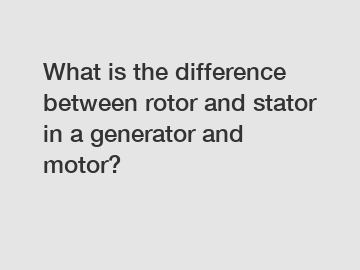What is the difference between rotor and stator in a generator and motor?
When it comes to understanding the inner workings of generators and motors, the concepts of rotor and stator are essential to grasp. These two components play vital roles in the functioning of these machines, and understanding the differences between them is crucial for anyone looking to delve deeper into the world of electrical engineering.
To put it simply, the rotor and stator are the two main parts of an electric motor or generator. The rotor is the moving part of the machine, while the stator is the stationary part. This fundamental difference is what allows these machines to convert electrical energy into mechanical energy (in the case of a motor) or mechanical energy into electrical energy (in the case of a generator).
Let's start by examining the rotor. In a motor, the rotor is the component that rotates and produces the mechanical motion. It is typically made up of a series of coils wound around an iron core and is connected to the shaft of the motor. When an electrical current is passed through the coils, it creates a magnetic field that interacts with the magnetic field produced by the stator, causing the rotor to spin and generate mechanical energy.

In contrast, the stator is the stationary part of the motor or generator. It is made up of a series of coils wound around iron cores and is responsible for creating a magnetic field that interacts with the rotor. By passing an electrical current through the coils of the stator, a magnetic field is produced that causes the rotor to spin in a motor or induces an electrical current in a generator.
One of the key differences between the rotor and stator is their respective roles in the operation of the machine. The rotor is responsible for converting electrical energy into mechanical energy (in the case of a motor) or vice versa (in the case of a generator), while the stator is responsible for creating the magnetic field that drives the motion of the rotor.
Another important distinction between the rotor and stator is their physical location within the machine. The rotor is typically located inside the stator and is free to rotate within it, while the stator is fixed in place and surrounds the rotor. This configuration allows the rotor to spin freely within the stator, generating the mechanical motion necessary for the operation of the motor or generator.
In addition, the materials used to construct the rotor and stator can also differ. The rotor is often made of materials such as copper or aluminum, which are good conductors of electricity and capable of producing strong magnetic fields. The stator, on the other hand, is typically made of materials such as iron or steel, which are good at conducting magnetic fields and are able to withstand high temperatures and mechanical stress.
Overall, the rotor and stator are essential components of motors and generators, each playing a crucial role in the conversion of electrical energy into mechanical energy or vice versa. Understanding the differences between these two components is key to grasping the inner workings of these machines and appreciating the complex interplay of electrical and magnetic forces that drive their operation.
In conclusion, the rotor and stator are fundamental components of electric motors and generators, each serving a unique role in the conversion of energy. By understanding the differences between these two parts, we can gain a deeper appreciation for the intricate workings of these machines and the complex interplay of forces that drive their operation. So next time you encounter a motor or generator, remember the crucial roles played by the rotor and stator in bringing these machines to life.
The company is the world’s best Sub-assembly production, Bus motor core, lamination welding supplier. We are your one-stop shop for all needs. Our staff are highly-specialized and will help you find the product you need.
207
0
0

Comments
All Comments (0)